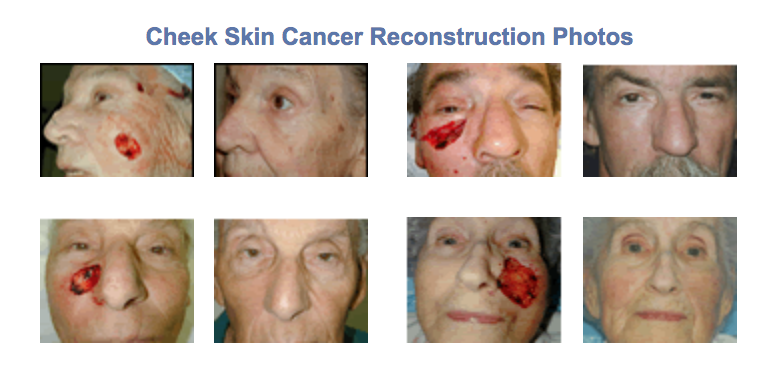Although large skin cancers can be seen with the naked eye, it takes a microscope to visualize cancer at the cellular level. The only way to prevent recurrence of localized skin cancer is to remove each and every cell; otherwise any remaining skin cancer cells can reproduce and cause a regrowth of the cancer. Mohs surgery is a specialized method to remove skin cancer. It is named in honor of Frederick Mohs, the physician who developed the technique. Mohs surgery differs from other methods of treating skin cancer by the use of detailed mapping techniques and onsite microscopic examination of the surgically removed skin. Mohs skin cancer surgery allows for the tissue to be examined during the operation through a microscope to ensure that all of the cancer cells have been removed adequately, and that removal of healthy, cancer-free tissue is minimized. Using the Mohs microscopic surgery technique there is a 95% cure rate. Mohs skin cancer surgery is then followed by careful reconstructive surgery to repair the defect (hole) and to yield an aesthetically pleasing result.
According to the American Cancer Society, there will be 1 million new cases of skin cancer this year, with the three most common types of skin cancer being Basal Cell Carcinoma, Squamous Cell Carcinoma and Malignant Melanoma. Basal Cell and Squamous Cell Carcinomas are usually localized and rarely spread to other parts of the body. When diagnosed and treated early, they are 95% curable. Malignant Melanoma is more serious as it has a propensity to metastasize (spread) to other areas of the body.
What are the most common areas of skin cancer?
The most common skin cancers occur on the eyelids, ears, nose, and cheeks. Be sure that you are applying sunscreen on your those areas. Most people put it on their forehead and cheeks, but fail to protect their ears, eyelids, and lips.
How can I reduced my risk of skin cancer?
To reduce your risk of skin cancer, it is important to minimize sun exposure, wear sun protection daily, have full body skin examinations yearly (or more frequently if you have a personal or family history of skin cancer) and to recognize the signs and symptoms of skin cancer:
-
- Melanoma: Comprises 4% of all skin cancers and usually appears as a dark lesion or mole that has changed in appearance. Look for changes of the ABCD’s – Asymmetry, irregular Border, Color varied within the mole from one area to the other or black in color, and increasing Diameter or diameter larger than a pencil eraser.
- Squamous Cell Carcinoma: Comprises 16% of all skin cancers and is characterized by a rough, flaky, red or pink patch of skin. At times these lesions can grow very rapidly, and are more common in smokers.
- Basal Cell Carcinoma: The most common skin cancer, comprising 80% of all skin cancers, it is characterized by a raised red or brown lesion or patch, with pearly, raised or rolled borders and an ulcerated raw or oozing center. Basal Cell Carcinoma usually grows slowly, and is more common in sun-exposed areas, such as the eyelids, ears, cheeks, lips, neck, and hands.
Is the skin cancer surgery done with anesthesia?
Your skin cancer surgery is performed with local anesthesia so you will be totally numbed up with injections of lidocaine to numb you. Although you are awake during the procedure, if you are anxious or the surgery is in a delicate area, you can be given valium or similar medications to relax you. (In that case, you will need someone to drive you home).
How long does the skin cancer surgery take?
There are 2 parts to the procedure. The first is removing the cancer and making sure all of the skin cancer cells are removed. After each excision, the tissue that was removed is examined under a microscope. This can take several tries (also known as “levels”) until the margins are clear of skin cancer cells. The second part of the procedure is the reconstruction. This can be a simple closure, or a more complicated operation. We won’t know how long the whole process will take ahead of time. You might need to be present for only an hour, or several hours.
Does Dr Hoenig take insurance for skin cancer reconstructive surgery?
Dr Hoenig does not accept insurance for skin cancer reconstruction. You will be expected to pay upfront for his expertise, but can then submit the documentation to your insurance carrier for reimbursement.
 More photos coming soon… If you are interested in learning more about Mohs skin cancer surgery and facial reconstruction surgery, please feel free to contact us for more information
More photos coming soon… If you are interested in learning more about Mohs skin cancer surgery and facial reconstruction surgery, please feel free to contact us for more information

